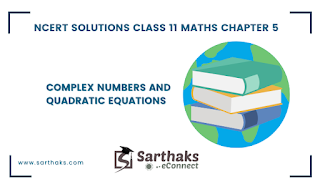NCERT Solutions Class 11 Maths Chapter 5 Complex Numbers and Quadratic Equations
Class 11 Math's NCERT Solutions Chapter 5: Complex Numbers and Quadratic Equations—All NCERT solutions for Class 11 Math's Chapter 5 are available below. This solution contains questions, answers, images, and explanations for the entire class 11 chapter 5, titled "Of Complex Numbers and Quadratic Equations. If you are a Class 11 student using an NCERT textbook to study math, you will come across Chapter 5: Complex Numbers and Quadratic Equations. After studying the lesson, you should be looking for answers to its questions. Complete NCERT Solutions for Class 11 Math's Chapter 5: Complex Numbers and Quadratic Equations can be found here.
The NCERT Solutions for Class 11 Math's Chapter 5:
Complex Numbers and Quadratic Equations from sarthaks.com include all of
the questions from NCERT Books prepared by Mathematics expert teachers in
accordance with CBSE NCERT guidelines. To help you score higher in your board
exams and competitive exams, download our free pdf of Chapter 5: Complex
Numbers and Quadratic Equations Math's NCERT Solutions for Class 11.
NCERT Solutions
Class 11 covers all important topics one needs for exam preparation.
·
Complex numbers are required because they are used extensively
in mathematics and physics. A complex number can be used to solve quadratic
equation zeros. If we come across a negative in any square root, we can use
complex numbers to simplify the zero. Complex numbers have applications in
electronics and electromagnetism.
·
Algebraic properties of complex numbers – for complex numbers
the properties of addition and multiplication are the same.
o
Closure property of addition – for any two complex numbers y1
and y2 the sum of y1 + y2 is also a complex number.
o
The commutative property – for any two complex numbers y1 and y2
we have y1 + y2 = y2 + y1
o
The associative property – for any two complex numbers y1, y2,
and y3 we have (y1+y2)+y3 = y1+(y2+y3)
o
The additive identity – there exists a complex number 0 = 0+0i
such that, for every complex number y, y + 0 = 0 + y = y. the complex number 0
= 0+0i is called the additive identity of complex number.
o The additive inverse – for every complex number y there exists a complex number –y such that y+(-y) = (-y)+y = 0. –y is called the additive inverse of z.
· Argand plane and polar
representation of complex numbers – the complex number x+iy refers to the
ordered pair (x,y) is geometrically represented as the unique point (x,y) in
the XY- plane. For example, the complex number, 2+7i corresponds to the ordered
pair (2,7) geometrically, and in the same way ordered pair -3+8i refers to the
(-3,2).
· Statement of Fundamental
Theorem of Algebra – every polynomial equation of degree n also has complex
number coefficients has n number of roots or solutions.
· Solution of quadratic
equations in the complex number system
· Square root of a complex
number
NCERT Solutions Class 11 Math's is an important part of students’ preparation for their boards and competitive exam preparation.



Comments
Post a Comment